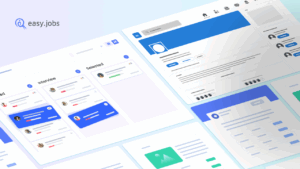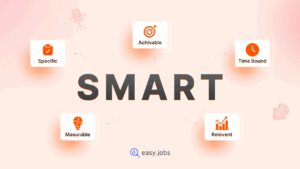No matter how big or small your company is, employee satisfaction is critical, which is why carrying out an employee happiness survey regularly is a must. Not only can employee happiness surveys boost your team’s morale, but they can also boost your profits. Do you want to upscale your organization’s human resource management? Then, let’s find out how you can successfully conduct an employee happiness survey and analyze the results for future improvement.
![How to Do Employee Happiness Survey [20 Questions & Analysis Process] 1 Employee Happiness Survey](https://easy.jobs/wp-content/uploads/2024/05/EJ-How-to-conduct-Employee-Happiness-Survey-10-Questions-Analyze-Process.jpg)
A study conducted by FTSE Russell examined 25 years of market data comparing the yearly returns of publicly traded companies on the ‘100 Best’ lists to those of the other companies. 83% of workers at the 100 Best Companies said their workplace was healthy, compared to just 52% at the typical U.S. The annual cost of lost productivity resulting from disgruntled employees is estimated to be over $350 billion in North America.
Why Should You Measure Employee Happiness?
Let’s start with what is employee happiness survey? A popular method for determining how satisfied workers are with their workplace, corporate culture, and general work experience is the employee satisfaction survey. The purpose of the survey is to gather information about the particular factors that influence employee satisfaction or dissatisfaction.
Companies can gain important and useful insights from measuring employee happiness. Because contented workers typically put in more discretionary effort and enthusiasm at work, as well as being more productive overall. Let’s look at the major accomplishments you will get by doing an employee happiness survey.
Gain Employee Satisfaction And Engagement
Happy employees are more likely to be engaged with their work, leading to higher productivity and better performance. Measuring happiness can provide insights into the overall satisfaction levels within the organization.
Reduce Turnover And Boost Retention
Higher turnover rates are a result of unhappy workers being more likely to quit. Organizations can detect areas of employee dissatisfaction and take proactive measures to address problems before they result in turnover by measuring happiness.
Build a Happy Workplace Culture
Employee happiness is closely linked to workplace culture. Measuring happiness can help organizations assess the effectiveness of their cultural initiatives. It also makes adjustments as needed to create a more positive and inclusive environment.
Assure Wellbeing And Health
Employee dissatisfaction increases the risk of stress, burnout, and other unfavorable health effects. Organizations may reduce employee stress and enhance general well-being by identifying and addressing the contributing factors with the aid of happiness measurement.
Upscale Customer Satisfaction
Happy employees are more likely to provide better customer service, leading to higher levels of customer satisfaction and loyalty. By doing employee happiness surveys and measuring them, organizations can indirectly gauge the potential impact on customer satisfaction and retention.
In a nutshell, happy employees are more likely to feel motivated to contribute new ideas and solutions. Measuring happiness can help organizations assess the level of creativity and innovation within their workforce and create an environment that fosters creative thinking.
How to Create an Employee Happiness Survey [Sample]
Creating an employee happiness survey is crucial for understanding the overall satisfaction and engagement levels within your organization. Here’s a step-by-step guideline to help you create an effective survey, along with some sample questions:
Step 1: Define the Purpose And Goals
Before conducting any survey, you should be clear on the purpose and goals. Ask yourself why you’re conducting the employee happiness survey. Is it to gauge overall satisfaction, identify areas for improvement, or measure the impact of recent changes? Then set specific goals you want to achieve with the survey, such as improving employee retention or increasing productivity.
Step 2: Choose a Survey Tool to Measure Happiness
The next step is to select an employee happiness survey tool that fits your needs and budget. Usually, HRM solutions provide tools to conduct versatile surveys. You can research the market and pick the most suitable one for managing human resources or go for custom-built surveys within your HR software. If you are looking for free and easy survey tools, then you can consider these: Google Forms, SurveyMonkey, Typeform, etc. In this survey form tools, you will get ready questions set for conducting employee surveys as well.
Step 3: Determine the Survey Frequency
Time to plan for the execution process. You have to decide how often you’ll administer the employee happiness survey. The common frequencies for the frequencies are quarterly or semi-annually. Call a stakeholder meeting before making final decisions to go over the reason, objective, time, and manpower requirements. Make sure it aligns with your organization’s needs and resources.
Step 4: Design Employee Happiness Survey Questions
Now let’s design the employee happiness survey questions and appearance. You can start with a brief introduction explaining the purpose of the survey and assuring confidentiality. Try to keep the survey concise to encourage higher participation rates. Give a check and ensure questions are clear, unambiguous, and easy to understand.
Here are the basic guidelines for creating questions:
- Use a mix of multiple-choice, Likert scale, and open-ended questions to gather quantitative and qualitative data.
- Group questions into categories such as work environment, leadership, work-life balance, and career development.
- Include questions that measure overall satisfaction, job engagement, and likelihood of recommending the company to others.
Step 5: Review And Run a Pilot Test
After setting everything up, you can go for the employee happiness survey. However, take a moment to go over the survey and make sure it is consistent, relevant, and clear before moving on. And it’s always crucial to run a pilot test. To find any problems or misunderstandings, you can test the survey on a small subset of the workforce.
![How to Do Employee Happiness Survey [20 Questions & Analysis Process] 2 Employee Happiness Survey](https://easy.jobs/wp-content/uploads/2024/05/image.jpeg)
Step 6: Distribute the Survey Form & Conduct It
Go over the above-mentioned steps once more. Now is the time to distribute the survey form among employees and conduct it. The goal of the survey, the schedule, and the confidentiality policy should all be explained to staff members before you begin. Choose the most appropriate method for distributing the survey, such as email, intranet, or paper-based forms. Also, don’t forget to set a deadline for submission.
Step 7: Take Action According to the Outcome
What’s next after conducting the employee happiness survey? You can share the survey results with employees to demonstrate transparency and accountability. Analyzing the result, develop action plans to address areas needing improvement based on survey findings. After that, communicate the actions being taken to address employee feedback and solicit ongoing input.
By following the above steps, you can distribute the benefits and conduct structured employee satisfaction surveys.
20+ Employee Happiness Survey Questions You Can Consider
As we have already seen, designing the employee happiness survey questions are the most crucial step. You have to do a lot of research and competitor analysis before setting them. To help you out, we have listed out the top rate questions from the most popular companies. Let’s check them out.
Ice-breaking questions
- Share your personal details, like name, address,
- How many years have you been working here?
- What do you enjoy most about working here?
- How much do you think your work matters and advances the objectives of the company?
Overall satisfaction questions
- On a scale of 1 to 5, how satisfied are you with your current role?
- How would you rate the overall work environment at our company?
- Would you recommend working at this company to a friend or family member?
- Do you feel valued and appreciated by your manager?
- Are you satisfied with the opportunities for career advancement within the company?
- What changes or improvements would you suggest to enhance employee satisfaction?
Work culture questions
- Do you feel comfortable expressing your ideas and opinions openly at work?
- How often do you receive recognition or praise for your work?
- How well do you feel your colleagues collaborate and work as a team?
- Do you feel you have been given the necessary resources and tools to perform your job effectively?
- Do you feel your workload is manageable?
- How well does the company support your work-life balance?
Career growth questions
- Do you feel the company has assisted you with clear career goals and development planning?
- Do you feel confident and empowered to make decisions within your role?
- Do you feel your manager provides you with clear and consistent communication?
Compensation And benefits questions
- Do you feel your current compensation and benefits package is fair and competitive?
- Do you feel your workload is manageable and appropriately compensated for the time you invest?
Best Practices to Boost Employee Engagement with Surveys
We know how to conduct the employee happiness survey. However, what is the best way to leverage it to increase employee engagement? Here are the best practices that you should consider:
- Make sure to maintain confidentiality. Ensure that staff members are at ease and secure enough to provide candid feedback by maintaining their anonymity at all times.
- Be sure to express yourself clearly. Describe the goal of the survey, the intended use of the results, and the measures taken to maintain confidentiality.
- Make sure you ask the appropriate questions. Aim for specific goals when crafting your questions, and stay away from vague or leading inquiries.
- Make sure it is brief and pertinent. Employees may find it challenging to concentrate on providing thoughtful responses, and longer surveys result in lower completion rates.
- Act upon the feedback, please. By developing an action plan based on the findings and sharing it with your staff, you can show that you appreciate their input.
How to Analyze Employee Satisfaction Survey Efficiently
![How to Do Employee Happiness Survey [20 Questions & Analysis Process] 3 Employee Happiness Survey](https://easy.jobs/wp-content/uploads/2024/05/image.png)
In order to gauge employee sentiment, pinpoint areas for development, and put plans in place to raise satisfaction, HR must examine employee happiness surveys. This is key to ultimately creating a more productive and engaged workforce. Here we are mentioning how you can analyze employee happiness surveys efficiently.
1. Compile, Organize & Clean Your Data
Ensure that all survey responses are properly formatted and organized by compiling them into a single dataset. Eliminate any redundant or insufficient responses to clean up the data. If necessary, give qualitative responses and numerical values to facilitate analysis.
2. Identify Employee Satisfaction Key Metrics
Choose which important metrics, such as work-life balance, engagement levels, overall satisfaction, and leadership effectiveness, to concentrate on. Sort metrics into priority lists according to how crucial they are to the aims and objectives of your company.
3. Conduct Descriptive Analysis
Start by performing descriptive analysis to get an overview of the survey results. Calculate basic statistics such as mean, median, mode, and standard deviation for each survey question. Create visualizations such as histograms, bar charts, and pie charts to represent the data.
4. Look for Trends And Patterns
Identify trends or patterns in the survey responses. Look for recurring themes or issues that are mentioned frequently. Pay attention to outliers or areas where responses deviate significantly from the norm.
5. Benchmark Against Previous Surveys
To monitor changes over time, compare the results of the current survey with those from earlier surveys. Determine which areas have improved or declined since the last survey, and look into the causes of those changes.
6. Communicate Findings And Recommendations
Prepare a comprehensive report summarizing the survey findings, insights, and recommendations. Present the findings to key stakeholders, including senior leadership, HR, and department managers. Facilitate discussions around potential actions and strategies to address identified issues.
7. Follow Up And Monitor Progress
Implement action plans based on the survey findings and monitor progress over time.
Conduct follow-up surveys or pulse checks to assess the impact of interventions and track ongoing employee satisfaction.
![How to Do Employee Happiness Survey [20 Questions & Analysis Process] 4 Employee Happiness Survey](https://easy.jobs/wp-content/uploads/2024/05/image-1.jpeg)
What’s Next?
⚡ Complete Guide To Measuring Diversity In The Workplace
⚡ Track 5 Important Recruiting Metrics & Improve Impact
⚡ 5 Ways To Build Equity for Underrepresented Communities
Survey Employee Satisfaction And Enforce a Happy Workplace
Conducting regular employee happiness surveys is a key indicator of a happy workplace. But remember, the worst thing you can do with your employee happiness survey is to ask for feedback and then do nothing with it. So, analyze the responses properly and take action strategically. This will surely bring greater satisfaction and growth to your company.
Do you want to keep up with the latest HR strategies? Then subscribe to our blog now.





